#PyAutoGUI
Explore tagged Tumblr posts
Text


deskpet mikey :)
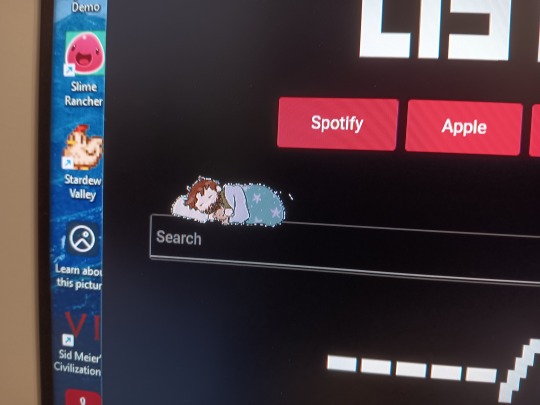
#if anyone wants him i can put him on a github repo with instructions on how to configure him to ur screensize / the right file path#also u need to have python and pyautogui installed and also he only works properly on windows. i need to fix the little white dots#i love my barely functional son 🫶#my art :D#woe.begone
61 notes
·
View notes
Text
Wondering what boop count your 3 letter word corresponds to? I gotchu:
Using a python script I wrote, I booped myself 50,000 times, saving an image of my boop-o-meter every 500 boops. Before we get into the results, there are two important limitations to this study that I should mention:
Firstly, because I only recorded the boop-o-meter every 500 boops, if a message appeared for less than 500 boops it may not have been caught.
Secondly, every now and then my computer would lose a boop or two when a click wouldn't register. This is seen in the 500 and 1000 boop images below, which in reality read 498 and 994 respectively. Because of this, boop values are slightly lower than they appear.
With that out of the way, lets dig in.
0-999:
From boops 0-999, the boop-o-meter displays your boop count, and changes color as you boop
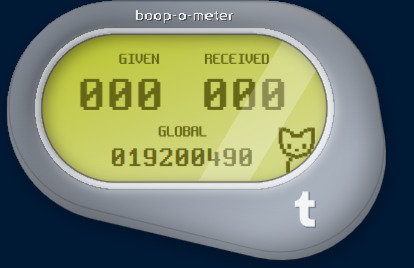
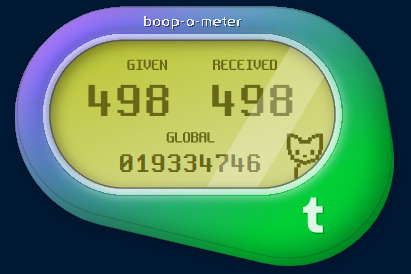

Boop count: 0 Boop count: 500 Boop count: 1000
Boop fact: the colors do not change after 1000
LOL:
Between boops 1000 and 1500, the boop-o-meter changed to display 'LOL'. This likely took place at 1000 boops, but maybe it said 'MAX' or sumn for awhile at first? Idk this is already the misinformation website so not my problem.
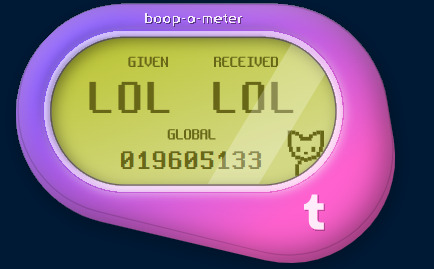
Boop count: 1500 (actually more like 1490 ish)
More results below the cut
OMG:
Between 1500 and 2000, the boop-o-meter changed to display 'OMG'. Again, this probably happened at 1500 but who knows. Maybe staff made it 1523 for the bit or something.
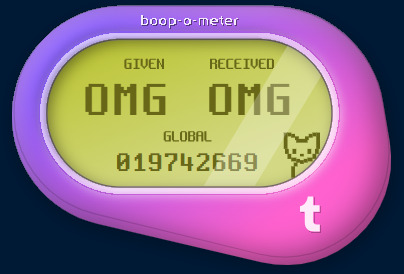
Boop count: ~2000
WOW:
The boop-o-meter remained at omg until the 3500 boop readpoint, when it switched to 'WOW', meaning this transition happens somewhere between ~2980 and ~3480.
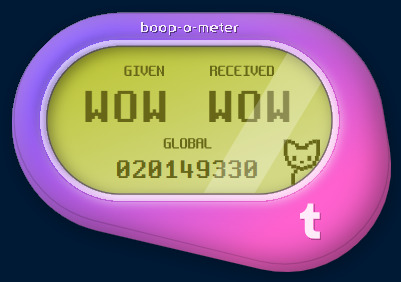
Boop count: ~3500
Boop fact: 'WOW' is the second longest reigning message
*-*:
Between 5000 and 5500 the boop-o-meter switched to '*-*'. You get the idea at this point so I'll speed it up.
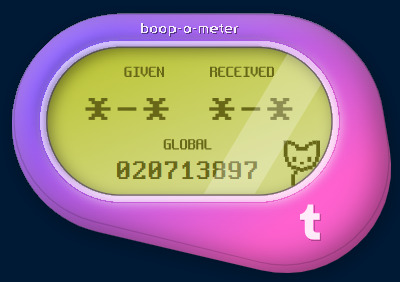
Boop count: ~5500
WHY:
The boop-o-meter changed to 'WHY' between 6000 and 6500 boops. For science. That's why.

Boop count: ~6500
PLZ:
Next was 'PLZ', switching between 7000 and 7500.
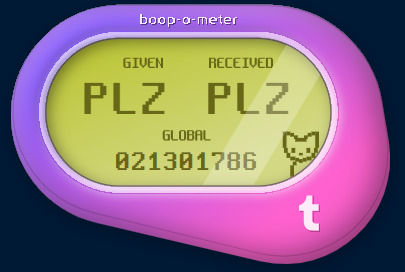
Boop count: ~7500
AAA:
I'm not sure what bloody urine has to do with anything, but for some reason staff felt is was important to display, switching between 7500 and 8000.
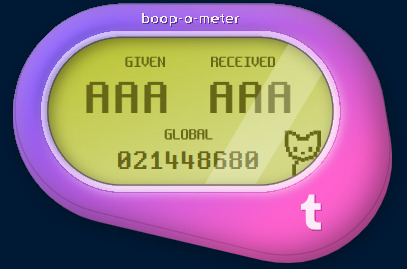
Boop count: ~8000
;_;:
Huh the colon makes that one look weird. 8000-8500.

Boop count: ~8500
Boop fact: That fucking cat haunts me in my dreams
0_0:
I realized after I set my pyautogui script running that my computer wouldn't turn off its screen because of the clicking, so there was a strobing blue light in my room all night. This encapsulated my expression while trying to sleep (8500-9000).
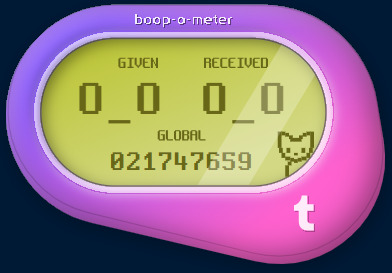
Boop count: ~9000
MAX:
After 9000 it displayed 'MAX'. This was cap. (9000-9500 switch).

Boop count: OVER 9000 (9500)
<33:
I miss my wife. 9500-10,000.

Boop count ~10,000
TUM BLR:
THE HOLY GRAIL. The boop-o-meter switched to displaying 'TUM BLR' between 10,000 and 10,500 boops. Because my actual boop count was slightly behind my theoretical, I'd guess that this change happened at 10,000 boops.

Boop count: ~10,500 (likely switched at 10,000)
Summary:
When charted the boop curve looks as follows:

Boop curve: 0 - 10,000 boops
My script continued to run until 53,000 boops, but no further changes were observed. Again, there were quite possibly more messages at lower boop values, but my ass is not checking. Maybe I should have scaled my sampling accordingly, but it is what it is. Thank you for joining me on this journey, and if you have any corrections or more information, please add it to this post.
Boop fact: Terfs DNI
7K notes
·
View notes
Text
Okay it's become clear to me that the real reason I'm on hiatus rn is because I just do not enjoy the more tedious aspects of making these posts and am delaying making more. Am I weak for this? Probably. But am I a quitter? Absolutely not. Version 2 is starting development now, and it will use pyautogui to make me not hate the process lmao. It will also include sharps, timing, more instruments, and probably some other stuff too. If you have any suggestions put them in the notes!
74 notes
·
View notes
Text
Сохраняем полезное: как «скрафтить» приложение для записи экрана на Python.
import cv2 import numpy as np import pyautogui # Устанавливаем разрешение для записи screen_width, screen_height = pyautogui.size() resolution = (screen_width, screen_height) # Устанавливаем имя выходного видеофайла output_filename = "screen_recording.mp4" # Устанавливаем количество кадров в секунду (FPS) для записи fps = 30.0 # Определяем кодек и создаем объект VideoWriter fourcc = cv2.VideoWriter_fourcc(*"mp4v") out = cv2.VideoWriter(output_filename, fourcc, fps, resolution) # Определяем продолжительность записи в секундах recording_duration = 5 # Измените это значение для задания нужной длительности записи # Начинаем запись экрана for _ in range(int(fps * recording_duration)): # Делаем снимок экрана screen = pyautogui.screenshot() # Конвертируем снимок экрана в numpy массив и формат BGR для OpenCV frame = np.array(screen) frame = cv2.cvtColor(frame, cv2.COLOR_RGB2BGR) # Записываем кадр в выходное видео out.write(frame) # Закрываем VideoWriter out.release()
4 notes
·
View notes
Text
What Are Python’s Key Features For Automation Tasks?
Python is widely recognized for its simplicity, readability, and a vast ecosystem of libraries, making it ideal for automation tasks. One of its key features is its clean syntax, which allows developers to write and understand scripts quickly, which is important when automating repetitive processes. Python supports cross-platform scripting, meaning automation scripts written in Python can run on Windows, Linux, or macOS with minimal changes.
Another strength is Python’s rich set of standard libraries like os, shutil, subprocess, and datetime, which help manage files, execute system commands, and schedule tasks. For more advanced automation, third-party libraries such as Selenium (for web automation), PyAutoGUI (for GUI automation), and Pandas (for data manipulation) are commonly used.
Python's integration capabilities also make it easy to automate tasks across different systems or software—like sending emails, processing spreadsheets, or interacting with APIs. In industries ranging from IT to marketing, Python is increasingly being used for automating testing, reporting, and workflows.
If you're new and looking to get started with scripting and automation, a good Python course for beginners can help build the foundation.
0 notes
Text
```markdown
SEO Automation with Python
In today's digital landscape, Search Engine Optimization (SEO) is more critical than ever for businesses looking to boost their online presence and drive traffic to their websites. However, managing SEO can be a time-consuming and complex process, especially when it comes to repetitive tasks like keyword research, content optimization, and backlink analysis. This is where Python comes in, offering a powerful toolset for automating these tasks and streamlining your SEO efforts.
Why Use Python for SEO?
Python is a versatile programming language that offers a wide range of libraries and frameworks specifically designed for web scraping, data analysis, and automation. Here are some key reasons why Python is an excellent choice for SEO:
1. Web Scraping: Python libraries like BeautifulSoup and Scrapy make it easy to extract data from websites, which is crucial for tasks like competitor analysis and keyword research.
2. Data Analysis: Libraries such as Pandas and NumPy allow you to analyze large datasets efficiently, helping you gain insights into your website's performance and identify areas for improvement.
3. Automation: With tools like Selenium and PyAutoGUI, you can automate repetitive tasks, saving you time and effort while ensuring consistency in your SEO strategies.
Practical Examples of SEO Automation with Python
Keyword Research
Keyword research is a fundamental part of any SEO strategy. By using Python, you can automate the process of identifying relevant keywords and analyzing their search volumes. Here’s a simple example using the `requests` library to fetch data from a keyword research API:
```python
import requests
def get_keyword_data(keyword):
url = f"https://api.example.com/keyword/{keyword}"
response = requests.get(url)
return response.json()
data = get_keyword_data("digital marketing")
print(data)
```
Content Optimization
Optimizing your content for search engines involves several steps, including keyword placement, meta tag optimization, and readability analysis. Python can help automate these tasks, ensuring your content is fully optimized for search engines.
```python
from bs4 import BeautifulSoup
def optimize_content(html_content, keyword):
soup = BeautifulSoup(html_content, 'html.parser')
title = soup.find('title')
if title:
title.string = f"{keyword} - {title.string}"
return str(soup)
optimized_html = optimize_content("<html><head><title>Example Title</title></head><body>Hello World!</body></html>", "SEO")
print(optimized_html)
```
Backlink Analysis
Backlinks are a crucial factor in determining a website's ranking on search engines. Python can help you automate the process of analyzing your backlinks and identifying opportunities for improvement.
```python
import requests
def analyze_backlinks(domain):
url = f"https://api.example.com/backlinks/{domain}"
response = requests.get(url)
return response.json()
backlinks = analyze_backlinks("example.com")
print(backlinks)
```
Conclusion
By leveraging Python for SEO automation, you can save time, increase efficiency, and gain valuable insights into your website's performance. Whether you're a seasoned SEO professional or just starting out, Python offers a powerful set of tools to help you achieve your goals. What other SEO tasks would you like to automate? Share your ideas in the comments below!
```
```
加飞机@yuantou2048

币圈推广
谷歌留痕
0 notes
Text
Python: The Versatile and Powerful Programming Language
Introduction
Python is one of the most popular programming languages in the world. Known for its simplicity, readability, and versatility, it has gained widespread adoption across various industries. From web development and data science to artificial intelligence and automation, Python has proven to be a language that empowers developers and businesses alike.
In this blog post, we will explore the origins of Python, its key features, popular frameworks and libraries, use cases, and future trends.
History of Python

Python was created by Guido van Rossum in the late 1980s and officially released in 1991. Van Rossum, a Dutch programmer, developed Python as a successor to the ABC programming language. His goal was to create a language that emphasized code readability and efficiency.
Python has undergone several major updates:
Python 1.0 (1991): The first official release with core features like exception handling and dynamic typing.
Python 2.x (2000): Introduced list comprehensions and garbage collection.
Python 3.x (2008 — Present): A major overhaul that improved Unicode handling, print statements, and object-oriented programming.
Python 2 was officially deprecated in 2020, and all modern developments focus on Python 3.
Key Features of Python

Python’s popularity stems from its numerous advantages, including:
1. Easy to Learn and Read
Python’s syntax is clear and concise, making it an excellent choice for beginners. Its use of indentation enforces clean code structure.
2. High-Level Language
As a high-level programming language, Python handles complex programming tasks like memory management automatically.
3. Interpreted Language
Python does not require compilation, allowing developers to run code directly and get instant feedback.
4. Dynamically Typed
Variable types are determined at runtime, reducing the need for explicit declarations.
5. Extensive Standard Library
Python comes with a rich set of built-in libraries that simplify tasks such as file handling, networking, and mathematical computations.
6. Cross-Platform Compatibility
Python runs seamlessly on Windows, macOS, and Linux, making it a truly cross-platform language.
7. Object-Oriented and Functional Programming
Python supports multiple paradigms, allowing developers to write both object-oriented and functional code.
8. Strong Community Support
With an active global community, Python offers extensive documentation, tutorials, and third-party libraries.
Popular Python Frameworks and Libraries
Python’s power comes from its vast ecosystem of frameworks and libraries. Here are some of the most widely used ones:
Web Development

Django: A high-level web framework for building secure and scalable web applications.
Flask: A lightweight and flexible framework ideal for microservices and RESTful APIs.
FastAPI: Designed for high-performance API development.
Data Science & Machine Learning
Pandas: Used for data manipulation and analysis.
NumPy: Provides support for large, multi-dimensional arrays and matrices.
Scikit-learn: A machine learning library for data mining and predictive analysis.
TensorFlow & PyTorch: Popular frameworks for deep learning and neural networks.
Automation & Scripting
Selenium: Automates web browsing tasks.
BeautifulSoup: Scrapes data from websites.
PyAutoGUI: Controls the keyboard and mouse programmatically.
Cybersecurity & Ethical Hacking
Scapy: Used for packet manipulation and network scanning.
Requests: Handles HTTP requests efficiently.
PyCrypto: Provides cryptographic functions.
Game Development
Pygame: A library for developing simple 2D games.
Godot Engine (GDScript with Python-like syntax): A popular game development framework.
Finance & FinTech
Quantlib: Used for financial analytics and modeling.
Zipline: A backtesting framework for trading strategies.
TA-Lib: Provides tools for technical analysis of stock data.
Use Cases of Python

Python is widely used in various domains due to its versatility. Here are some key areas where Python plays a significant role:
1. Web Development
Python is used to build websites and web applications with frameworks like Django, Flask, and FastAPI.
2. Data Science & Analytics
Python is the primary language for data scientists, thanks to libraries like Pandas, NumPy, and Matplotlib.
3. Machine Learning & AI
With TensorFlow, PyTorch, and Scikit-learn, Python enables AI-driven applications such as facial recognition, natural language processing, and predictive analytics.
4. Cybersecurity & Ethical Hacking
Python is commonly used for penetration testing, network security, and malware analysis.
5. Game Development
Python’s simplicity makes it a great choice for prototyping and developing indie games.
6. Automation & Scripting
Python automates repetitive tasks like file management, data entry, and email processing.
7. Internet of Things (IoT)
Python is used in IoT applications for controlling smart devices and handling sensor data.
8. Finance & FinTech
Python is extensively used for stock market analysis, trading algorithms, and risk management.
Click here to see how it works
Future Trends in Python

Python continues to evolve with emerging technologies. Some exciting trends include:
1. AI and Machine Learning Dominance
Python remains the leading language for AI and machine learning applications, with ongoing improvements in TensorFlow and PyTorch.
2. Growth of WebAssembly (WASM) with Python
Python is expected to play a role in WebAssembly, making web applications faster and more efficient.
3. Python in Quantum Computing
Libraries like Qiskit and Cirq are driving Python’s presence in quantum computing research.
4. Enhanced Performance with PyPy
PyPy, an alternative Python implementation, is improving execution speed and memory efficiency.
5. Increased Use in Cybersecurity
As cybersecurity threats rise, Python’s role in ethical hacking and security analysis will expand further.
6. Edge Computing & IoT Expansion
Python’s adoption in IoT and edge computing will increase, supporting smart cities and automation.
7. Python for Blockchain Development
Python is being used to build blockchain applications and smart contracts.
0 notes
Text
Mastering Python 3: A Step-by-Step Guide
Python 3 is a powerful, versatile, and beginner-friendly programming language used in various fields, including web development, data science, automation, and artificial intelligence. Whether you are a complete beginner or looking to enhance your skills, following a structured learning approach will help you master Python efficiently.
Considering the kind support of Python Course in Chennai Whatever your level of experience or reason for switching from another programming language, learning Python gets much more fun.

1. Getting Started with Python Basics
Before diving into complex topics, it’s essential to understand the fundamentals of Python. Learn about Python syntax, variables, and data types such as strings, integers, lists, tuples, and dictionaries. Master control structures like if-else statements, loops (for and while), and functions to write reusable and efficient code.
2. Writing and Running Your First Programs
Hands-on practice is key to mastering Python. Start by writing simple programs such as a calculator, a to-do list, or a number guessing game. Use interactive coding platforms like Codecademy, Replit, or Jupyter Notebook to test and debug your code easily.
3. Understanding Object-Oriented Programming (OOP)
Object-Oriented Programming is essential for developing scalable applications. Learn how to create and use classes and objects. Understand key OOP principles like inheritance, encapsulation, polymorphism, and abstraction. Try building a small project using OOP concepts, such as a basic inventory system or a contact management application.
4. Diving into Intermediate Python Concepts
Once you’re comfortable with the basics, explore more advanced topics, including:
File Handling: Reading and writing files in Python.
Error Handling: Using try-except blocks to handle exceptions.
Regular Expressions: Searching and manipulating text data efficiently.
Modules and Packages: Organizing code into reusable components.
5. Working with Databases and APIs
Python is widely used for data management. Learn how to interact with:
SQL Databases like MySQL and SQLite to store structured data.
NoSQL Databases like MongoDB for flexible data storage.
APIs using the requests library to fetch and integrate external data. With the aid of Best Online Training & Placement Programs, which offer comprehensive training and job placement support to anyone looking to develop their talents, it’s easier to learn this tool and advance your career.

6. Choosing a Specialization in Python
Depending on your career goals, Python offers multiple specializations:
Web Development – Learn Django or Flask for backend development.
Data Science & Machine Learning – Work with Pandas, NumPy, Scikit-learn, and TensorFlow.
Automation & Scripting – Use Selenium, PyAutoGUI, and OpenCV.
Cybersecurity & Ethical Hacking – Explore penetration testing tools with Python.
7. Building Real-World Python Projects
Applying Python to real-world projects enhances learning and problem-solving skills. Try building:
A web scraper using BeautifulSoup.
A chatbot with AI integration.
A data visualization dashboard using Matplotlib and Seaborn.
8. Contributing to Open Source and Networking
Join the Python community by contributing to open-source projects on GitHub. Engage in discussions on platforms like Stack Overflow, Reddit, and Discord. Collaborating with others helps you learn best practices and stay updated with the latest trends.
9. Preparing for Python Certifications and Job Interviews
If you aim to use Python professionally, consider earning certifications such as:
Google IT Automation with Python.
Microsoft Certified: Python Associate.
PCEP (Certified Entry-Level Python Programmer).
Prepare for job interviews by solving Python coding challenges on LeetCode, CodeWars, and HackerRank.
10. Staying Updated and Continuous Learning
Python evolves with new libraries and frameworks. Keep learning by following Python blogs, watching tutorials, and working on new projects. Experimenting with trending technologies like AI, blockchain, and cloud computing will keep your Python skills relevant and in demand.
By following this step-by-step guide, practicing regularly, and working on real-world projects, you can progress from a beginner to an expert in Python 3 and unlock a wide range of career opportunities.
0 notes
Text
Python is used for automation due to its simplicity, readability, and vast libraries like Selenium, PyAutoGUI, and Pandas. It enables task automation, web scraping, data processing, and script execution, improving efficiency and reducing manual effort across various domains.
0 notes
Text
Python vs. JavaScript: Which Should You Learn First?
Choosing the right programming language to learn first can be a daunting decision, especially for beginners. Python and JavaScript are two of the most popular languages today, each offering unique advantages and use cases. This article compares Python and JavaScript to help you decide which one aligns better with your goals.
1. Overview of Python
a. What is Python?
Python is a high-level, general-purpose programming language known for its simplicity and readability. Created by Guido van Rossum in 1991, Python emphasizes code readability with its clean and straightforward syntax.
b. Key Features of Python:
Ease of Learning: Simple syntax similar to plain English.
Versatility: Used in web development, data analysis, machine learning, automation, and more.
Large Community: Extensive libraries and frameworks for various tasks.
c. Popular Use Cases:
Data Science and Machine Learning (e.g., TensorFlow, pandas)
Web Development (e.g., Django, Flask)
Scripting and Automation
Scientific Computing
2. Overview of JavaScript
a. What is JavaScript?
JavaScript is a dynamic programming language primarily used for creating interactive web applications. Developed by Brendan Eich in 1995, it’s the backbone of front-end web development.
b. Key Features of JavaScript:
Versatility: Runs on both client-side (browser) and server-side (Node.js).
Rich Ecosystem: Supports various frameworks like React, Angular, and Vue.js.
Event-Driven: Ideal for interactive web applications.
c. Popular Use Cases:
Web Development (both front-end and back-end)
Mobile App Development (e.g., React Native)
Game Development
Building APIs
3. Ease of Learning
Python:
Python’s simple syntax makes it an excellent choice for beginners.
Requires less code to achieve tasks compared to other languages.
The language’s design minimizes confusion for newcomers.
JavaScript:
JavaScript has a steeper learning curve due to its event-driven nature and complex features like closures and asynchronous programming.
Beginners may find the concept of the DOM (Document Object Model) and the dynamic behavior of JavaScript challenging at first.
Verdict: Python is generally easier for beginners.
4. Job Opportunities and Market Demand
Python:
High demand in data science, machine learning, and AI roles.
Common in backend development and automation.
Frequently used in academia and scientific research.
JavaScript:
Essential for front-end development; nearly all websites use JavaScript.
Growing demand for full-stack developers using JavaScript frameworks like Node.js.
Popular in startups and tech companies focusing on web and app development.
Verdict: Both languages have strong job prospects, but Python leads in data-related fields, while JavaScript dominates web development.
5. Performance and Speed
Python:
Python is an interpreted language, which makes it slower than compiled languages.
Not ideal for performance-critical applications.
JavaScript:
Faster due to its Just-In-Time (JIT) compilation.
Optimized for web browsers and real-time applications.
Verdict: JavaScript is faster, especially for real-time applications.
6. Community and Learning Resources
Python:
Extensive community support and beginner-friendly documentation.
Many free courses and tutorials available for data science, web development, and more.
JavaScript:
A large and active community with a focus on web development.
Abundant resources for learning frameworks and libraries.
Verdict: Both languages offer excellent learning resources, but Python’s community is slightly more beginner-focused.
7. Tools and Frameworks
Python:
Web Development: Django, Flask
Data Science: NumPy, pandas, scikit-learn
Automation: Selenium, PyAutoGUI
JavaScript:
Front-End Frameworks: React, Angular, Vue.js
Back-End Frameworks: Node.js, Express.js
Mobile Development: React Native, Ionic
Verdict: Python excels in data-related tools, while JavaScript dominates web development frameworks.
8. Long-Term Relevance
Python:
Its role in emerging fields like AI and machine learning ensures long-term relevance.
Versatility makes it adaptable to various industries.
JavaScript:
As the primary language of the web, JavaScript’s relevance is unlikely to diminish.
Constantly evolving with new frameworks and updates.
Verdict: Both languages are here to stay, making them safe choices.
9. When to Choose Python
Consider Python if you:
Are a complete beginner looking for an easy-to-learn language.
Want to work in data science, machine learning, or automation.
Prefer a language with straightforward syntax.
10. When to Choose JavaScript
Consider JavaScript if you:
Aim to become a front-end or full-stack developer.
Want to build interactive websites or mobile apps.
Are interested in mastering a versatile language for web development.
Conclusion
Python and JavaScript are both excellent choices for beginners, each catering to different goals. If you’re drawn to data science, automation, or backend development, Python is a fantastic starting point. For those passionate about web development and creating interactive applications, JavaScript is the way to go. Ultimately, the best language to learn first depends on your interests and career aspirations. Whichever you choose, mastering the fundamentals will set you up for success in the dynamic world of programming.
0 notes
Text
IMPORTANT ANNOUNCEMENT FOR ALL BOOPERS

We are halfway through the day and only 5% of the way to maxing out the global boop-o-meter. In a last-ditch effort I am releasing my automated booping script. It can run anywhere you can run python, and only requires the pyautogui and time libraries. The code is below the cut, and extremely scuffed as I am in physics not cs. Happy booping.
import pyautogui as pg
import time
def boop_spam():
"""
Spam an account with boops. WARNING: You will not be able to use your computer while this is running, as this operates via automated mouse movements.
Test it out with boop count of 10 to make sure you have the hang of it before picking a larger number.
If you accidentally set it running for a very long period of time, you can either restart your computer to stop it,
or wait for every 200th boop where there will be a 5s pause where you can click the garbage icon on your terminal
"""
while(True):
print("Hover mouse over the first button, then press enter")
input()
x1, y1 = pg.position()
print("Hover mouse over the second button, then press enter")
input()
x2, y2 = pg.position()
print("Input boop count")
boop = int(input())
for i in range(boop):
pg.click(x1, y1)
time.sleep(0.1)
pg.click(x2,y2)
time.sleep(0.1)
if i%200 == 0:
time.sleep(5)
print("Continue? (y/n)")
cont = input()
if cont != 'y':
print("Breaking")
break
boop_spam()
290 notes
·
View notes
Note
Is no one even going to try and do bad apple???
To be honest somebody probably has, but my askbox has so many requests rn I haven't gotten round to it. Maybe I should learn pyautogui so the script can handle the more tedious parts of the process as well...
32 notes
·
View notes
Text
Automating Tasks with Python and the PyAutoGUI Library
Introduction Automating tasks with Python and the PyAutoGUI library is a powerful way to streamline repetitive tasks, increase productivity, and reduce manual labor. In this comprehensive tutorial, we will cover the basics of automating tasks with Python and PyAutoGUI, including core concepts, implementation guide, code examples, best practices, testing, and debugging. What Readers Will…
0 notes
Text
マウスやキーボードを自動制御するためのPythonライブラリ「PyAutoGUI」サンプルコードと一緒に基本的な使い方を解説
PyAutoGUIとは PyAutoGUIは、Pythonでマウスやキーボードを制御し、GUIの自動操作を実現するライブラリです。 日常的な定型作業の自動化やテスト作業の効率化に活用できます。 実際の人間の操作をプログラムで再現できる点が大きな特徴です。 インストール方法 pipコマンドを使用して簡単にインストールできます。 pip install pyautogui 基本的な使い方 PyAutoGUIを使用するには、最初にインポートする必要があります。 import pyautogui # 安全機能の設定 pyautogui.FAILSAFE = True # マウスを左上に移動すると停止 pyautogui.PAUSE = 1.0 # 操作間の待機時間を1秒に設定 キーボード操作の制御方法 テキスト入力やキー操作を自動化できます。特殊キーの組み合わせにも対応しています。 #…
0 notes
Text
Python mouse bot 滑鼠機器人小程式
讓透過使用者預先定義的動作,操作滑鼠。 program.py (使用 pyautogui) import pyautoguiimport time # 讀取設定檔案with open("settings.txt", "r") as settings_file: lines = settings_file.readlines() # 解析每一行指令for line in lines: # 移動到指定位置 if line.startswith("moveTo"): _, x, y = line.split() pyautogui.moveTo(int(x), int(y), 0.5) # 點擊 elif line.startswith("click"): if "right" in line: …
View On WordPress
0 notes
Text
The Power of Python: Exploring its Versatility and Endless Applications
Python, hailed for its simplicity, versatility, and readability, has established itself as a powerhouse in the realm of programming languages. Since its inception in 1991 by Guido van Rossum, Python has garnered widespread adoption among developers of all levels of expertise. In this comprehensive guide, we'll explore the multifaceted nature of Python, its elegant syntax, and its wide-ranging applications that make it indispensable across various industries.

Unraveling the Essence of Python: An Overview of the Language
Python emerges as a high-level, interpreted programming language celebrated for its clean and concise syntax. Its readability and simplicity make it an ideal choice for beginners while offering advanced capabilities for seasoned developers. Python's philosophy prioritizes simplicity and clarity, fostering a community-driven ethos that values collaboration and innovation.
Discovering Python's Core Features: The Building Blocks of Excellence
Python encompasses a rich set of features that underpin its versatility and robustness. Key attributes include:
Readable and expressive syntax that promotes code clarity and maintainability
Dynamic typing and automatic memory management for enhanced developer productivity
An extensive standard library that facilitates rapid application development
Comprehensive documentation and strong community support, fostering a collaborative learning environment
Cross-platform compatibility, ensuring seamless deployment across diverse environments
Considering the kind support of Learn Python Course in Hyderabad, Whatever your level of experience or reason for switching from another programming language, learning Python gets much more fun.
Exploring Python's Diverse Applications: From Web Development to Data Science
Python's versatility transcends boundaries, finding applications across a myriad of domains. Let's delve into some of the prominent use cases of Python:
1. Web Development with Python: Crafting Dynamic and Scalable Solutions
Python's robust frameworks such as Django and Flask have revolutionized web development, empowering developers to create sophisticated, scalable web applications effortlessly. Django, renowned for its "batteries-included" approach, provides a comprehensive toolkit for building complex applications, while Flask offers a lightweight, minimalist framework ideal for rapid prototyping and API development.
2. Data Science and Machine Learning with Python: Harnessing the Power of Data
Python's extensive ecosystem of libraries, including NumPy, Pandas, Matplotlib, and scikit-learn, has positioned it as the preferred language for data analysis, visualization, and machine learning tasks. With Python, data scientists can leverage powerful tools for data manipulation, visualization, and model development, driving insights and innovation in diverse domains.

3. Automation with Python: Streamlining Workflow Efficiency
Python's simplicity and versatility make it an invaluable asset for automation tasks across industries. From scripting routine administrative tasks to orchestrating complex workflows, Python empowers developers to automate processes efficiently. With libraries such as Selenium and PyAutoGUI, developers can automate web scraping, GUI testing, and more, enhancing productivity and scalability.
4. Artificial Intelligence and Natural Language Processing with Python: Pioneering Intelligent Solutions
Python's rich ecosystem of AI and NLP libraries, including TensorFlow, PyTorch, and NLTK, positions it as a frontrunner in the development of intelligent applications. With Python, developers can build and deploy sophisticated AI models, perform advanced text analysis, and create conversational interfaces that revolutionize user interactions.
5. Game Development with Python: Bringing Imagination to Life
Python, complemented by libraries like Pygame, offers a versatile platform for game development. Its simplicity and ease of use make it accessible to developers of all skill levels, enabling them to bring their creative visions to life. With Python, developers can prototype and build 2D games efficiently, fostering innovation and creativity in the gaming industry. Enrolling in the Best Python Certification Online can help people realise Python's full potential and gain a deeper understanding of its complexities.
6. Scripting with Python: Simplifying System Management
Python's scripting capabilities make it indispensable for system administration and automation tasks. Its cross-platform compatibility ensures seamless execution of scripts across diverse environments, facilitating system management and orchestration. With Python, developers can automate routine tasks, perform file operations, and streamline system workflows with ease.
Conclusion: Embracing Python for Innovation and Excellence
In conclusion, Python's unparalleled versatility and simplicity position it as a cornerstone in modern software development. From web development to data science, automation, AI, and beyond, Python offers a powerful toolkit that empowers developers to innovate and create transformative solutions across industries. As Python continues to evolve and adapt to emerging technologies, its impact on the world of software development remains unrivaled, driving innovation and excellence in the digital age.
0 notes